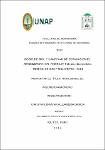| dc.contributor.advisor | Ávila Fucos, Manuel Calixto | |
| dc.contributor.author | Alejandria Garcia, Christian Jonatan | |
| dc.date.accessioned | 2021-01-22T13:54:08Z | |
| dc.date.available | 2021-01-22T13:54:08Z | |
| dc.date.issued | 2019 | |
| dc.identifier.uri | http://repositorio.unapiquitos.edu.pe/handle/20.500.12737/7104 | |
| dc.description.abstract | El trabajo de investigación se realizó en la Universidad Nacional de la Amazonia
Peruana en la Facultad de Agronomía en el Proyecto Vacunos en el Fundo de
Zungarococha, titulado dosis de biol y cantidad de estacas en el rendimiento del
forraje Tithonia diversifolia “botón de oro” en loreto- 2019. Las evaluaciones
fueron realizadas a la décima semana después de la siembra con semilla
vegetativa (estacas), en parcelas de 3 m x 1.2 m (3.6 m2) y un área experimental
de 170 m2. Con un Diseño de Bloques Completo al Azar (D.B.C.A), con una
factorial de 2 x 2 con cuatro tratamientos y cuatro repeticiones, los tratamientos
en estudio fueron: T1 (Biol al 20 % + una estaca/golpe), T2 (Biol al 20 % + tres
estaca/golpe), T3 (Biol al 40 % + una estaca/golpe) y T4 (Biol al 40 % + tres
estaca/golpe), obteniendo los siguientes resultados: Con la dosis de 40 % de biol
y con tres estacas/golpe, se logró incrementar la altura de planta, materia verde,
materia seca, y los rendimientos de materia verde por parcela y por hectárea. En
este sentido, se demostró que las dosis de biol y número de estacas/golpe influyen
favorablemente en las características agronómicas de forraje Tithonia
diversifolia, además tuvieron una marcada influencia en los indicadores de
producción con respecto a la otra dosis y numero de estacas. El porcentaje (%)
de cobertura Se incremento de la dosis de biol (40%) y mayor número de estacas
(3 estacas/golpe). De acuerdo con lo encontrado en este trabajo, Tithonia
diversifolia o “botón de oro” se presenta como una alternativa para la
suplementación de la dieta alimenticia de animales monogástricos y rumiantes. Se
debe considera que es una especie forrajera de fácil adaptación a los sistemas
agropecuarios por su fácil propagación y manejo en el cultivo. | es_PE |
| dc.description.abstract | The research work was carried out at the National University of the Peruvian
Amazon in the Faculty of Agronomy in the Vacunos Project in the Zungarococha
Farm, entitled dose of biol and quantity of cuttings in the yield of the forage Tithonia
diversifolia "gold button" in loreto- 2019. The evaluations were carried out at the
tenth week after sowing with vegetative seed (stakes), in plots of 3 mx 1.2 m (3.6
m2) and an experimental area of 170 m2. With a Random Complete Block Design
(DBCA), with a factorial of 2 x 2 with four treatments and four repetitions, the
treatments under study were: T1 (Biol at 20% + one stake / hit), T2 (Biol at 20 % +
three stake / hit), T3 (40% Biol + one stake / hit) and T4 (40% Biol + three stake /
hit), obtaining the following results: With the dose of 40% biol and with three
cuttings / blow, it was possible to increase the height of the plant, green matter, dry
matter, and the yields of green matter per plot and per hectare. In this sense, it
was shown that the doses of biol and number of cuttings / hit favorably influence
the agronomic characteristics of forage Tithonia diversifolia, also had a marked
influence on the production indicators with respect to the other dose and number
of cuttings. The percentage (%) of coverage increased the dose of biol (40%) and
increased number of stakes (3 stakes / hit). According to what was found in this
work, Tithonia diversifolia or "buttercup" is presented as an alternative for the
supplementation of the food diet of monogastric and ruminant animals. It should
be considered that it is a forage species easily adapted to agricultural systems due
to its easy propagation and management in the crop. | en_US |
| dc.format | application/pdf | es_PE |
| dc.language.iso | spa | es_PE |
| dc.publisher | Universidad Nacional de la Amazonía Peruana | es_PE |
| dc.rights | info:eu-repo/semantics/openAccess | es_PE |
| dc.rights | Attribution-NonCommercial-NoDerivs 3.0 United States | * |
| dc.rights.uri | http://creativecommons.org/licenses/by-nc-nd/3.0/us/ | * |
| dc.source | Universidad Nacional de la Amazonía Peruana | es_PE |
| dc.source | Repositorio institucional - UNAP | es_PE |
| dc.subject | Abonos orgánicos | es_PE |
| dc.subject | Dosis de aplicación | es_PE |
| dc.subject | Forraje verde | es_PE |
| dc.subject | Botón dioso | es_PE |
| dc.subject | Tithonia diversifolia | es_PE |
| dc.subject | Esquejo | es_PE |
| dc.subject | Rendimiento de cultivos | es_PE |
| dc.title | Dosis de biol y cantidad de estacas en el rendimiento del forraje Tithonia diversifolia “botón de oro” en Loreto - 2019 | es_PE |
| dc.type | info:eu-repo/semantics/bachelorThesis | es_PE |
| thesis.degree.discipline | Agronomía | es_PE |
| thesis.degree.grantor | Universidad Nacional de la Amazonía Peruana. Facultad de Agronomía | es_PE |
| thesis.degree.name | Ingeniero(a) Agrónomo | es_PE |
| thesis.degree.program | Presencial | es_PE |
| dc.subject.ocde | http://purl.org/pe-repo/ocde/ford#4.01.06 | es_PE |
| renati.author.dni | 47909240 | |
| renati.advisor.dni | 05327621 | |
| renati.type | http://purl.org/pe-repo/renati/type#tesis | es_PE |
| renati.discipline | 811036 | es_PE |
| renati.level | http://purl.org/pe-repo/renati/level#tituloProfesional | es_PE |
| renati.juror | Reátegui Quispe, Victoria | es_PE |
| renati.juror | Manrique Del Aguila, Julio Abel | |
| renati.juror | Chávez Vásquez, Rafael | |
| dc.publisher.country | PE | es_PE |


